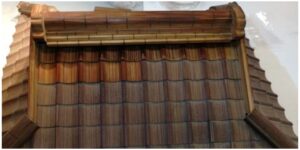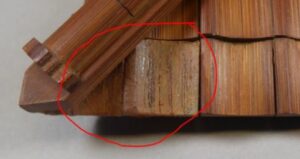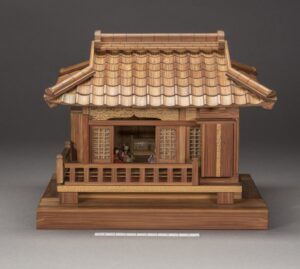December ’20
Japanese Dollhouse
The object is a wooden Japanese dollhouse from the Oriental Museum collections.

Dollhouses, which first appeared four hundred years ago in Europe, always had idealised interior and exterior decoration with detailed furniture and dolls.
Dollhouses, were traditionally created for children to play with but they have also been collected by adults, or created by adults. Some dollhouses are even miniatures of houses in real life.

Older dollhouses often show the style and typology of a house of a certain period. Compare this dollhouse to traditional houses in Japan; it appears to be a simplified miniature of such a house. They share similar architecture style, similar building materials, similar layout, similar components and even similar construction methods.
Traditional Japanese houses usually consists of verandas, sliding windows and doors, tatami mats, ceilings, roofs with tiles, rain shutters and shutter storage boxes. These elements can all be seen on this dollhouse, strengthening the argument it is a miniature of a traditional Japanese house.
Condition
- Evidence of dust and dirt on the surface
- Several pieces of the dollhouse have warped
- Excess adhesive on the surface from past repairs
- Structural instability due to adhesive failure.
Conservation

Dry cleaning methods were employed initially for the dollhouse as it was believed this was the option that would cause minimal damage. Surface dust and dirt was removed using a museum vacuum on low suction, and soft brush. Following this, the more ingrained surface dirt was removed using a combination of Smokesponge and Groomstick.
A number of areas of ingrained dirt were unable to be removed using dry cleaning methods and so wet cleaning was considered. Although it is desirable to avoid adding moisture to an organic object, there are situations where it is unavoidable. In this situation, a solvent which will not cause damage to the object is preferable. As such an appropriate solvent was found which successfully removed the ingrained dirt without causing damage to the object. This solvent was also able to remove several areas of excess old adhesive from what appeared to be a previous repair.

It was noticed during the initial assessment of the object that a number of pieces of the dollhouse had warped at some point either during use or while in storage. As the object was intended to be reconstructed the warped sections which would affect structural integrity were to be reshaped.
Local humidification was chosen as the method for reshaping the distorted sections, and once the sections had become flexible enough weights were used to help reshape the pieces as they dried.

In order to reconstruct the Japanese dollhouse a suitable adhesive for organic materials was chosen and applied. The dollhouse was reconstructed slowly, piece by piece in order to ensure strong bonds were formed between the pieces. During this process it became apparent that there several pieces missing, including a roof tile, two roof supports, and one window support.
As the losses were distracting to the eye, the decision was made to replicate them; although the original pieces were made from bamboo, this was not used for the replicas so that the additions would be distinguishable from the original material.

The roof and window supports were replicated by carving a comparative type of wood, whereas the roof tile, which was more complex in design, was made by moulding an original tile and creating a cast using resin which was then colour matched.
Stay tuned for next month’s object!
